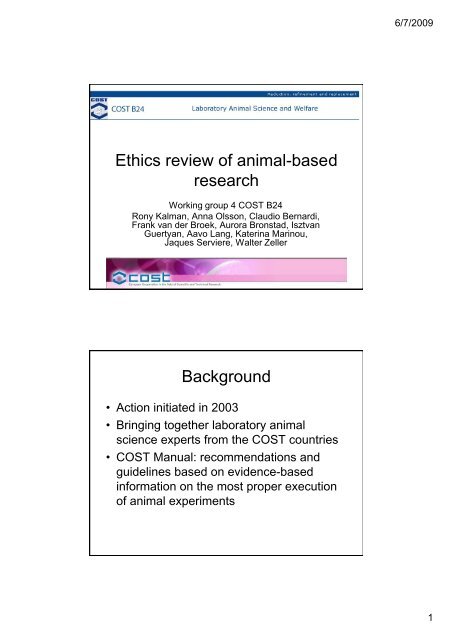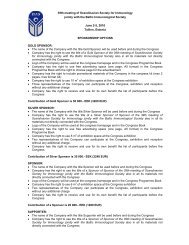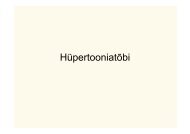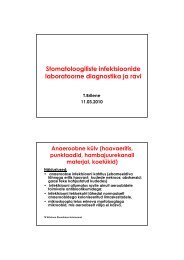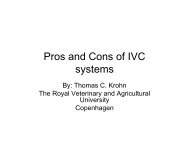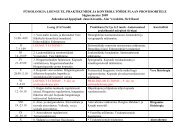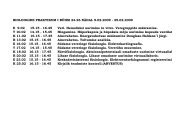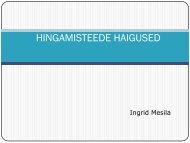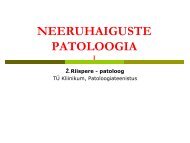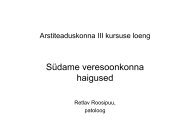Anna Olsson
Anna Olsson
Anna Olsson
Create successful ePaper yourself
Turn your PDF publications into a flip-book with our unique Google optimized e-Paper software.
Ethics review of animal-based<br />
research<br />
Working group 4 COST B24<br />
Rony Kalman, <strong>Anna</strong> <strong>Olsson</strong>, Claudio Bernardi,<br />
Frank van der Broek, Aurora Bronstad, Isztvan<br />
Guertyan, Aavo Lang, Katerina Marinou,<br />
Jaques Serviere, Walter Zeller<br />
Background<br />
• Action initiated in 2003<br />
• Bringing together laboratory animal<br />
science experts from the COST countries<br />
• COST Manual: recommendations and<br />
guidelines based on evidence-based<br />
information on the most proper execution<br />
of animal experiments<br />
6/7/2009<br />
1
Ethics review - background<br />
• Most European countries have some kind<br />
of ethics review system in place<br />
• No reference to ethics review in Directive<br />
86/609/EEC<br />
• Unclear how ethics will be dealt with under<br />
revised Directive<br />
• ?Evidence ?Evidence-based ?Evidence based information?<br />
• Expert opinion + critical discussion<br />
Organization<br />
• Check-list of key issues to be addressed in<br />
a review<br />
– Tool for new committees (and new committee<br />
members) finding their way of working<br />
– Quality tool for crosschecking review work of<br />
existing committees<br />
• Discussion of potential and limitation for<br />
considering aspects<br />
6/7/2009<br />
2
Checklist for ethics reviews<br />
• Description and purpose of the study<br />
• Replacement<br />
• Refinement<br />
• Reduction<br />
• Competence<br />
• Other aspects<br />
– Composition of an ethics committee<br />
Ethics committee composition<br />
Minimum expertise<br />
• Scientists with knowledge and expertise in<br />
biological and biomedical research.<br />
• Veterinarian (preferably with qualifications<br />
in laboratory animal medicine)<br />
• A person without affiliation to the<br />
requesting organization<br />
6/7/2009<br />
3
Ethics committee composition<br />
Additional valuable expertise<br />
– Animal technician / caretaker<br />
– Animal protection organizations<br />
– Patient organization<br />
– Statistician<br />
– People with knowledge on alternatives to the<br />
use of animals<br />
– People with knowledge on animal welfare<br />
– Ethicist<br />
The ethics review<br />
Description and purpose of the study<br />
• Is there a description of the background<br />
and scientific reasoning of the general<br />
research and is the hypothesis to be<br />
tested specified?<br />
6/7/2009<br />
4
Replacement<br />
• Is there a precise statement clarifying<br />
why animals cannot be replaced by nonanimal<br />
approaches?<br />
• Is it clear that alternatives have been<br />
evaluated and which literature and<br />
databases have been consulted?<br />
Refinement<br />
• Is the origin of animals intended to be used in the<br />
experiments clear?<br />
– If not standard laboratory animal breeder, (i.e. animals from<br />
the wild), are methods for capture, restraint, identity marking<br />
and transport described and is the acclimatization period<br />
defined?<br />
– Do the animals have special needs (specific congenital<br />
conditions, altered immunological status etc.).<br />
• Is it clear how the animals will be prepared, handled<br />
and acclimatized prior to the experiment?<br />
• Are all experimental stages clear in terms of time scale<br />
and types of procedures involved (acclimatization<br />
phase, experimental phase, termination)?<br />
6/7/2009<br />
5
Refinement<br />
• Is there a clear protocol for anesthesia and pain<br />
control? Are doses, volumes, administration routes<br />
and frequency, and treatment duration reasonable for<br />
the species and actual procedure performed – and are<br />
they in accordance with relevant literature?<br />
• Are the Humane Endpoint (HEP) Criteria well defined<br />
and are the actions to be taken when reaching these<br />
criteria clear? Is it clearly identified who within the<br />
organization will be finally responsible to make the<br />
decision (attending veterinarian, scientists,<br />
management, other)?<br />
Refinement<br />
• Is there a list of techniques performed during<br />
the experiments? How will these techniques<br />
and the data collection influence the animals?<br />
• Are the follow up inspections with the animals<br />
described, and are they sufficient to identify<br />
potential complications in time?<br />
• Is method and time of euthanasia clearly<br />
defined? If there are any alternatives to<br />
euthanasia available (i.e. sanctuary for<br />
primates, return to herd for farm animals), are<br />
they specified?<br />
6/7/2009<br />
6
Refinement<br />
• Is there a description of housing and experimental<br />
conditions and enrichment for the animals?<br />
– If special housing conditions (i.e. metabolic cages, single<br />
housing) are requested for the experiment, are they<br />
described?<br />
– If special housing conditions (i.e. moist diet, extra bedding) are<br />
required to guarantee animal welfare, are they described?<br />
– Is the social housing adequate to the animal species and the<br />
research design described?<br />
– Do facilities fulfil all requirements necessary to carry out this<br />
study? (experimental areas, rooms for postoperative care,<br />
special condition for microbiological containment, etc.)<br />
• Has this experiment been evaluated and classified<br />
according to a severity classification system?<br />
Reduction<br />
• Has the committee been assured that only the optimal<br />
number of animals requested is being used in the<br />
study? Was a proper analysis performed on these<br />
aspects by a qualified person?<br />
• Has the potential conflict between the reduction of<br />
number of animals and fairness to the individual<br />
animal been considered in this experiment ?<br />
• Is the re-use of animals an option in this application? If<br />
yes, has the severity of the two experiments (previous<br />
one and the requested one) been taken into<br />
consideration?<br />
• Has the option of performing a limited pilot study been<br />
addressed by the researcher, and if this option was<br />
considered but not taken, was it justified?<br />
6/7/2009<br />
7
Competences<br />
• Is it clear who the principal researcher in the<br />
project is?<br />
• Are his or her qualifications and competence<br />
clear and sufficient?<br />
• It there a list of the other participants in the<br />
research group? Does the list include details<br />
on education and training of personnel<br />
involved in the procedures?<br />
• Has any experts been consulted during the<br />
study design and the preparation of the<br />
application (statistician, veterinarian, animal<br />
welfare officer, other)?<br />
Organization<br />
• Check-list of key issues to be addressed in<br />
a review<br />
• Discussion of potential and limitation<br />
for considering aspects<br />
6/7/2009<br />
8
Limited benefit as a reason to<br />
deny a license<br />
• Ethics review is often described (and<br />
possibly perceived by the public) as<br />
balancing animal harm against benefit to<br />
humans (and other animals)<br />
• Committees usually focus on the animal<br />
harm side<br />
• To fulfil their responsibility towards the<br />
public, committees should possibly<br />
address both<br />
Limited benefit as a reason to<br />
deny a license<br />
• Law rules out some uses: tobacco product<br />
development (UK), cosmetics (EU)<br />
• On the other hand, law also “rules in”<br />
uses: safety testing of products however<br />
futile these are perceived<br />
• Do committees really have remit to decide<br />
here?<br />
6/7/2009<br />
9
Replacement alternatives<br />
• Standard question - under present<br />
directive, llegal to use animals if nonanimal<br />
method exist<br />
• Replacement alternatives exist mainly for<br />
some standard procedures (toxicity) +<br />
teaching<br />
• Replacement in science generally means<br />
a change of approach – attitudes of<br />
scientists rather than ethics committee<br />
decisions<br />
Responsibility and authority:<br />
humane endpoints<br />
• HEP means that data collection from an<br />
animal stops when it has reached predefined<br />
clinical status<br />
• Potential conflict of interest between many<br />
involved:<br />
– Animal caretakers / technicians inspecting<br />
animal<br />
– Scientist running study<br />
– Veterinarian responsible for animal welfare in<br />
the facility<br />
6/7/2009<br />
10
Responsibility and authority:<br />
humane endpoints<br />
• Not applying HEPs when they should be<br />
applied means more suffering than<br />
necessary<br />
• Veterinary decision carries most weight<br />
(ETS123, 86/609/EEC)<br />
• Involving all personnel in planning to<br />
prevent conflicts<br />
• Ethics committee to handle conflicts adhoc<br />
Severity banding<br />
• Speed up procedure<br />
• Transparency<br />
• Severity: number or an equivalent term<br />
(e.g. “moderate”), with various and quite<br />
often obscure underlying algorithms of<br />
calculation<br />
• Making this procedure too automatic risks<br />
the quality<br />
6/7/2009<br />
11
Study design: the need for<br />
qualified personnel<br />
• Optimal number of animals – again a<br />
standard question<br />
• Power analysis or equivalent to estimate<br />
animal numbers<br />
• However dependent on specialized<br />
knowledge only a scientist from the field<br />
knows: variation, size of biologically<br />
relevant effect etc<br />
Study design: the need for<br />
qualified personnel<br />
• More efficient to educate the scientists and<br />
to require them to consult with statisticians<br />
than to try to cover this aspect in detail in<br />
the committee<br />
• It may still be useful for the committee to<br />
have a statistician linked to them to<br />
discuss protocols that seem weak or<br />
otherwise complicated<br />
6/7/2009<br />
12
Reduction and standardization<br />
• Standardizing to reduce number of<br />
animals<br />
• Narrowing down the range of conditions<br />
(sex, age, genotype) reduces the potential<br />
for extrapolation<br />
• Consider possible culling of animals if only<br />
one sex used<br />
Reduction and standardization<br />
• Narrowing down the range of conditions<br />
reduces the potential for extrapolation<br />
• Systematic variation rather than increased<br />
variation (e g several inbred strains rather<br />
than one outbred, several housing<br />
conditions)<br />
• Animal studies in general use too few<br />
animals – n for animal studies much<br />
smaller than the reduction in variation<br />
(compared to human clinical trials) justifies<br />
6/7/2009<br />
13
Reduction vs Refinement<br />
• Repetitive use of animals when not part of<br />
the same protocol<br />
• The benefit of Reduction compared with<br />
the additional cost in Refinement<br />
• The level of the total burden (including<br />
possible non-recovery from first<br />
intervention)<br />
• Total duration plus recovery interval<br />
Review of previous projects –<br />
harm evaluation<br />
• Information about animal welfare / animal<br />
harm in previous projects potentially very<br />
useful in hte evaluation of future projects<br />
using similar approaches<br />
• Information not found in existing literature<br />
• Committees with retrospective review<br />
process can do this internally<br />
• Central database for information transfer<br />
across committees<br />
6/7/2009<br />
14
Ensuring scientific validity<br />
• Scientific validity critical for ethical<br />
acceptability<br />
• Most committees do not address<br />
• Assumed ensured through funding<br />
• But not all work funded through peerreviewed<br />
applications<br />
• Funding application often not detailed<br />
enough<br />
Ensuring scientific validity<br />
• Concurrent scientific application<br />
(assuming ethics is evaluated by<br />
somebody else) and ethics application<br />
(assuming science is evaluated by<br />
somebody else) means harm is not<br />
weighed against benefits<br />
• Evaluation for funding should include<br />
overall ethics assessment<br />
• Ethics committee should evaluate details<br />
6/7/2009<br />
15
Communicating with the public<br />
• Transparency versus need to protect<br />
information (innovation and personal<br />
integrity concerns)<br />
• Freedom-of-information acts will enable<br />
access also to this information<br />
• Proactive – online publication of lay<br />
summaries<br />
Appropriate level of review<br />
• Project, experiment, procedure?<br />
• Different levels mean different focus and<br />
review possibilities<br />
• Project: replacement<br />
• Experiment: reduction<br />
• Procedure: refinement<br />
6/7/2009<br />
16
Appropriate level of review<br />
• The proposed checklist aims to include<br />
everything<br />
– Mission impossible?<br />
– Adminstrative burden for ethics committees – and<br />
scientists<br />
• Alternative: general review (on project level) +<br />
trust that institutions have mechanisms in place<br />
to ensure use of refined techniques, competent<br />
personnel etc<br />
The social role of the ethics review<br />
committee<br />
• ‘Culture of care’ – responsible use of<br />
animals<br />
• “Trust is good – control is better” – or?<br />
• Education<br />
• Discussion of ethical issues – internally<br />
and with the public<br />
6/7/2009<br />
17
• To the COST office<br />
for supporting this<br />
action and Timo<br />
Nevalainen for<br />
initiating it<br />
• To working group<br />
members<br />
Thanks<br />
• For your attention<br />
• olsson@ibmc.up.pt<br />
6/7/2009<br />
18


